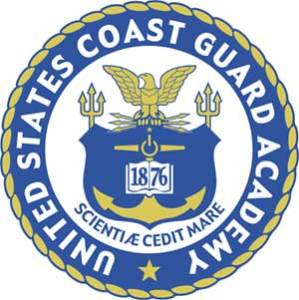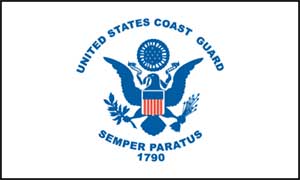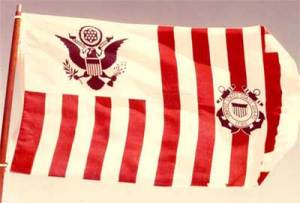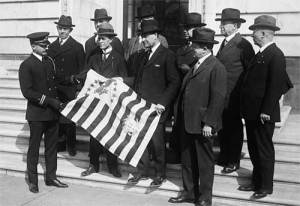Coast Guard Academy’s flags multiply
 Bedecked with school flags and guidons, the Coast Guard Academy in New London, Connecticut, is marking the centenary of its 1915 founding. But it’s somewhat confused about its own standard.
Bedecked with school flags and guidons, the Coast Guard Academy in New London, Connecticut, is marking the centenary of its 1915 founding. But it’s somewhat confused about its own standard.
According to the school’s website, “the origins of the Coast Guard standard are very obscure. It may have evolved from an early jack.” According to the Oxford English Dictionary, a jack is “a ship’s flag of smaller size than the ensign, used at sea as a signal, or as a mark of distinction.” It is often “flown from the jack-staff at the bow of a vessel” and signals the vessel’s nation of origin.
 The Coast Guard supports its supposition through a 1917 drawing that shows the “standard as a white flag with a blue eagle and 13 stars in a semi-circle surrounding it.” Eventually, words would be added to the flag: “United States Coast Guard – Semper Paratus,” meaning “always prepared.” The flag evolved again about a half-century ago when the semi-circle became a full circle.
The Coast Guard supports its supposition through a 1917 drawing that shows the “standard as a white flag with a blue eagle and 13 stars in a semi-circle surrounding it.” Eventually, words would be added to the flag: “United States Coast Guard – Semper Paratus,” meaning “always prepared.” The flag evolved again about a half-century ago when the semi-circle became a full circle.
 But, if you think you’re done learning about Coast Guard flags, think again. As the website explains, the Coast Guard is unique because it has “two official flags, the Coast Guard standard and the Coast Guard ensign.”
But, if you think you’re done learning about Coast Guard flags, think again. As the website explains, the Coast Guard is unique because it has “two official flags, the Coast Guard standard and the Coast Guard ensign.”
Back we go to the service’s website, which notes that the ensign was put in place in 1799 “in pursuance of authority from the President.” It has “16 perpendicular stripes, alternate red and white, the union of the ensign to be the arms of the United States in a dark blue on a white field.”
 So, is that the conclusion of the story of the Coast Guard’s school banners and flags? Nope. The service also has:
So, is that the conclusion of the story of the Coast Guard’s school banners and flags? Nope. The service also has:
*a commission pennant that signals that a commissioned officer is aboard a ship;
*the Coast Guard Color, which is the standard but with extras, such as fringe and a finial on the flagstaff in the shape of a battle axe;
*the Coast Guard Guidon, which is a swallowtail;
*personal flags for the commandant, vice commandment and various admirals;
*command pennants that fly when an officer “below flag rank” is in command;
*award pennants, given for various achievements; and
*the sailing club’s own colors.
Happy 100th birthday to the Coast Guard Academy, even though the Guard has existed since 1790. But that’s another story altogether.
(See the Coast Guard’s many banners, pennants and guidons at www.seaflags.us/uscg/uscg.html.)
